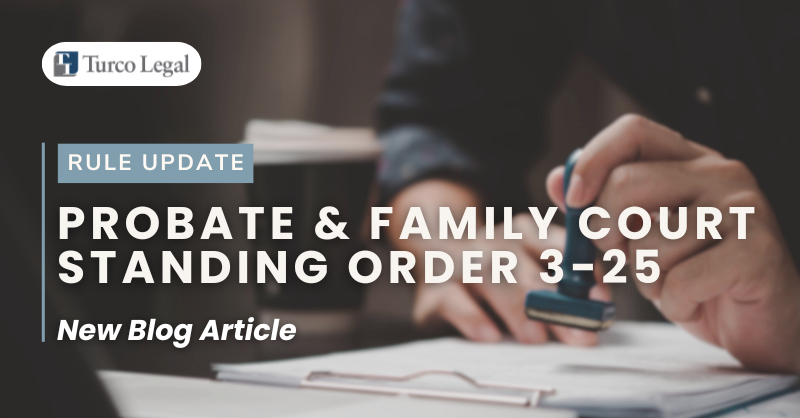Probate & Family Court Standing Order 3-25:
A New Building Block in the Court’s Effort To Fortify a Sturdy Foundation for the Administration of Justice
As August begins, pro se litigants and attorneys should note “Probate and Family Court Standing Order 3-25: Trial Completion.”
Effective July 1, 2025, it is a vital and welcome addition to the trial court’s governance framework.
Background
By way of background, let’s consider what a Standing Order is and how it applies systemically. In short, A Standing Order is a written order that applies to every Probate and Family Court in Massachusetts. The Standing Order, which affects all family law matters, remains in effect unless modified or rescinded by the Court.
Why Was a Change Needed?
For years, litigants have endured a chaotic, disjointed system—proof that “justice delayed is justice denied. (1)” Litigants, trial attorneys, judges, and court personnel know well the reality in Probate and Family Court. During a trial’s pendency, significant gaps often occur—sometimes lasting days, weeks, or even months—between trial dates. This causes immense frustration for all involved. Moreover, it restricts & compromises a litigant’s ability to present their case clearly and on time. After all, over the course of intervening weeks or months, how could a trial judge reasonably be expected to recall certain details and nuances of the case that could well impact their ultimate orders? Adding to the frustrations for all involved is the common reality that case files often become waylaid.
Additionally, it is not unusual for a different judge to be assigned to the matter. Key trial information—such as business or real estate valuations—can also become stale over time.
Recognizing these shortcomings and limitations, the Probate and Family Court initiated Standing Order 3-25. This reflects ongoing efforts to evaluate system strengths and weaknesses. The Court identifies vital practical changes and crafts workable solutions. These improvements benefit litigants, counsel, judges, and court personnel alike.
Reading Between the Lines of Standing Order 3-25
Everyone involved in the court system recognizes the gamesmanship and dilatory tactics at play. Such behavior clearly amounts to foul play. For example, some trial attorneys try to gain an advantage by fragmenting trial proceedings. This strategy undermines opposing counsel’s ability to present their best case. Another common happenstance occurs when an attorney represents a client who has withered under cross-examination and appeared not to be credible; the hope may be that, over time, the judge will not recall the negative impression left by their client and the attorney can use the delayed time to rehabilitate the litigant’s image. Legal fees and costs can escalate unnecessarily from a trial’s fits and starts. If maintaining the status quo benefits an attorney’s client—or enriches the attorney—why rush the process?
How Standing Order 3-25 Redresses Inefficiency and Unfairness
The goal is to improve systemic “efficiency and fairness” while reducing chicanery. Accordingly, the emphasis has decidedly shifted away from delayed justice administration. Instead, it now prioritizes a structured trial framework. Trials are scheduled in such a way that they commence and conclude within a time period that minimizes such delay.
For trial matters starting on or after July 1, 2025—the Standing Order’s effective date—Standing Order 3-25 immediately governs scheduling and procedures. It directly impacts how such trials are scheduled and managed. To prevent any potential confusion, note that this Standing Order overrides contradictory provisions in other Standing Orders. For example, this standing order takes precedence over Standing Order 1-06. It governs Case Management and Time Standards in Probate and Family Court.
The key provisions and corresponding redress in the Standing Order are as follows:
- Efficiency: Gaps between assigned trial dates are foreshortened to avoid lengthy delays so that trials are completed “within a reasonable time” once the trial begins
- Scheduling: Standing Order 3-25 mandates that trial days be scheduled sequentially (or, as reasonably close to consecutive days as the trial judge’s calendar can accommodate)
- Prioritizing: In the event a trial is not completed within the original calendar dates allotted, litigants and their counsel must prioritize the judge’s schedule over any conflicting calendar commitments on their respective schedules
- 30-day Rule: If the trial does not conclude within the originally allotted time, then the earliest available date(s) within 30 calendar days from the last scheduled trial date must be assigned
- Preemption: With the exception of certain scheduled motions, contempts, and pre-trials, if there are no dates that fall within the “30-days rule” involving trials that are scheduled but not yet commenced, then those nascent trials are to be rescheduled to a later date on the judge’s calendar
- Accurate estimate of trial duration—It is the duty of pro se litigants and attorneys of record to provide the court with good faith and accurate estimations of the requisite time for either trial completion or trial extension. The judge may impose a limitation on the number of requested trial days, “within the confines of due process …to ensure a timely and fair” trial. Once the judge decides, litigants and counsel must adhere to those limitations.
In short, Standing Order 3-25 sets clearly articulated directives. These promise a giant leap forward in the courts’ ongoing quest for fair justice administration.
(1) This legal maxim is said to have been coined in 1868 by former United Kingdom Prime Minister William Gladstone and referenced in 1963 by Reverend Martin Luther King Jr. in his “Letter from Birmingham Jail.”

